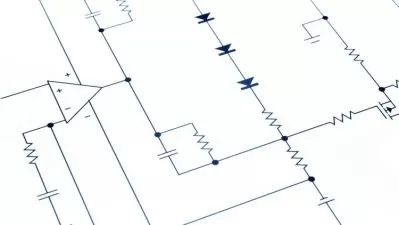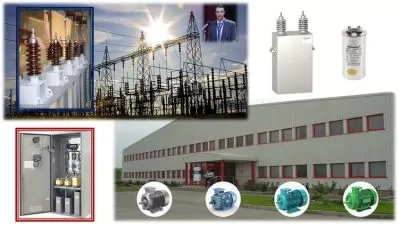Operational Amplifier - From Basics to Advance
VPACHKAWADE Research Center
7:11:41
Description
Learn basics, advances and simulation of circuits using Operational Amplifier
What You'll Learn?
- Learn how the operational amplifier (op-amp) works
- A wide range of circuits analyzed and built using op-amps
- Learn how to analyse op-amp circuits and compare the design results with the analysis
- Grow skills, knowledge and carrier propspective
- Use a industry standard circuit schematic software to design and simulate op-amp circuits
Who is this for?
What You Need to Know?
More details
DescriptionNew topics added :Â
Operational amplifiers or more commonly known as op-amps are the mostly used building blocks in the design and development of today's discrete and integrated electronic modules and systems. Op-amps are useful in designing and implementing many useful functions to perform a wide range of mathematical and logical operations. Primarily, op-amps are used to build high precision amplifiers, filters, and timing circuits. In this short modular course, we learn the fundamentals of op-amps, starting with the basic concepts and understand the principle of operation of op-amps. We learn about the op-amp equivalent model, ideal and practical properties of the op-amps such as open and closed loop gain (coomon-mode and differential), bandwidth, input and output resistance, etc. This is then followed by understanding the concept of virtual short, negative feedback and two most useful op-amp configurations, i.e. inverting and non-inverting amplifiers. We also understand how an op-amp can be used to convert input current into an output voltage (current-to-voltage converter).
This course then takes forward the learners to understand how an op-amp can be configured into a weighted summing amplifier (adder). This is explained in lecture 5, and in the same lecture, we understand the important role of negative feedback in the opamp. We then learn about op-amps used as a voltage follower (buffer). This circuit has an application when there is the impedance imbalance between the high impedance source and the low impedance load. We also design a circuit for a specific gain as explained by the example given.
Op-amp is essentially a difference amplifier and we understand and derive an expression of its closed-loop gain for both inverting and non-inverting modes. We understand the merits and few demerits of difference amplifiers and therefore we then introduce another popular circuit, called as Instrumentation Amplifier (IA). We explain the operation of IA and explain how IA offers improved differential input resistance and also helps to reject common-mode signals, the two most important parameters while designing an amplifier circuit with high gain.
As the course moves ahead, we introduce a few important building blocks of op-amps, i.e. active filters. We explain an active filter (integrator) using an operational amplifier, derive expressions to obtain its frequency response ( how gain and phase varies as a function of frequency). We then learn about active filters (differentiator) using operational amplifiers. Both inverting and non-inverting circuit modes are explained to design low-pass and high-pass filters. Most importantly, the course introduces LTSPICE (a circuit simulation program) to design, simulate and analyse the response for a given values of a circuit components used in the filter circuits. The course then moves forward to explain how to design an active bandpass filter circuit. We choose component values, design and simulate the circuit and obtain the output response. The simulation results are analysed and compared with the theoretical analysis in the course. It is shown how to theoretically analyze the circuit response, choose component values, design the circuit, simulate, obtain its responses and compare the results to match with the theory.
Who this course is for:
- Beginner, intemediate, and advanced learners in the semiconductor industry
- Engineers
- Professionals
- Engineering students
New topics added :Â
Operational amplifiers or more commonly known as op-amps are the mostly used building blocks in the design and development of today's discrete and integrated electronic modules and systems. Op-amps are useful in designing and implementing many useful functions to perform a wide range of mathematical and logical operations. Primarily, op-amps are used to build high precision amplifiers, filters, and timing circuits. In this short modular course, we learn the fundamentals of op-amps, starting with the basic concepts and understand the principle of operation of op-amps. We learn about the op-amp equivalent model, ideal and practical properties of the op-amps such as open and closed loop gain (coomon-mode and differential), bandwidth, input and output resistance, etc. This is then followed by understanding the concept of virtual short, negative feedback and two most useful op-amp configurations, i.e. inverting and non-inverting amplifiers. We also understand how an op-amp can be used to convert input current into an output voltage (current-to-voltage converter).
This course then takes forward the learners to understand how an op-amp can be configured into a weighted summing amplifier (adder). This is explained in lecture 5, and in the same lecture, we understand the important role of negative feedback in the opamp. We then learn about op-amps used as a voltage follower (buffer). This circuit has an application when there is the impedance imbalance between the high impedance source and the low impedance load. We also design a circuit for a specific gain as explained by the example given.
Op-amp is essentially a difference amplifier and we understand and derive an expression of its closed-loop gain for both inverting and non-inverting modes. We understand the merits and few demerits of difference amplifiers and therefore we then introduce another popular circuit, called as Instrumentation Amplifier (IA). We explain the operation of IA and explain how IA offers improved differential input resistance and also helps to reject common-mode signals, the two most important parameters while designing an amplifier circuit with high gain.
As the course moves ahead, we introduce a few important building blocks of op-amps, i.e. active filters. We explain an active filter (integrator) using an operational amplifier, derive expressions to obtain its frequency response ( how gain and phase varies as a function of frequency). We then learn about active filters (differentiator) using operational amplifiers. Both inverting and non-inverting circuit modes are explained to design low-pass and high-pass filters. Most importantly, the course introduces LTSPICE (a circuit simulation program) to design, simulate and analyse the response for a given values of a circuit components used in the filter circuits. The course then moves forward to explain how to design an active bandpass filter circuit. We choose component values, design and simulate the circuit and obtain the output response. The simulation results are analysed and compared with the theoretical analysis in the course. It is shown how to theoretically analyze the circuit response, choose component values, design the circuit, simulate, obtain its responses and compare the results to match with the theory.
Who this course is for:
- Beginner, intemediate, and advanced learners in the semiconductor industry
- Engineers
- Professionals
- Engineering students
User Reviews
Rating
VPACHKAWADE Research Center
Instructor's Courses
Udemy
View courses Udemy- language english
- Training sessions 25
- duration 7:11:41
- English subtitles has
- Release Date 2024/03/10











